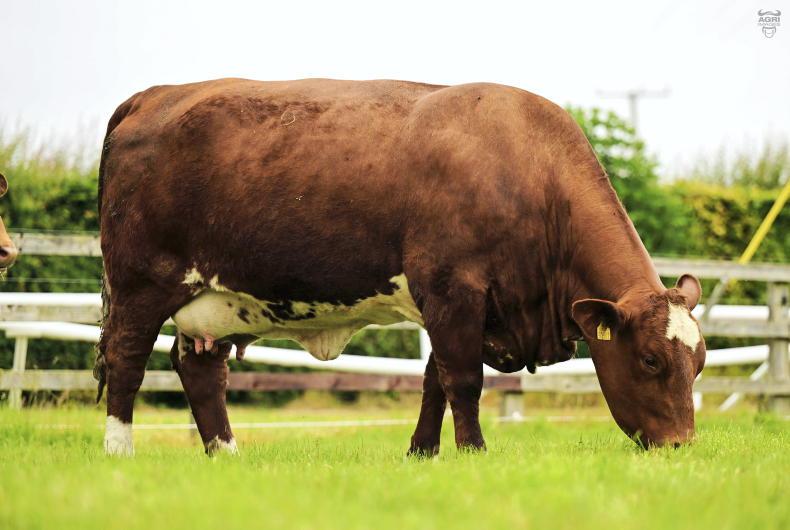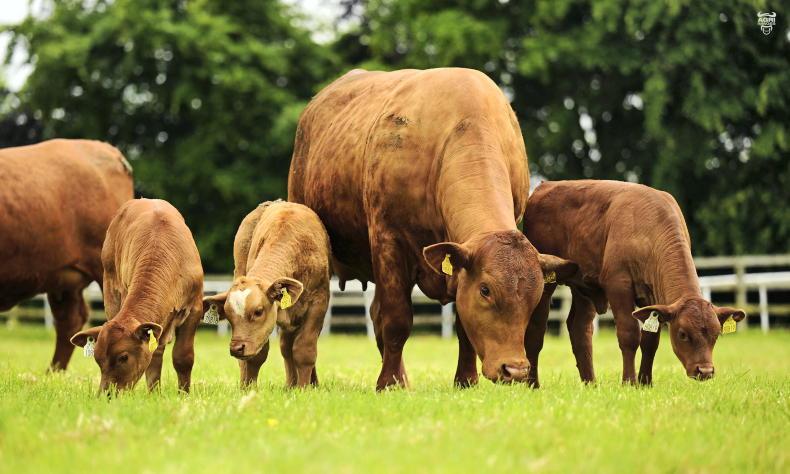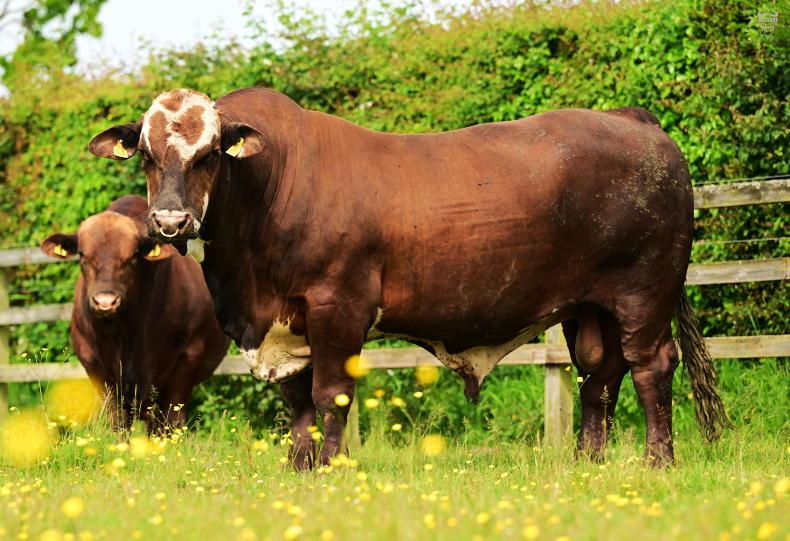Ireland’s suckler herd is probably best known for its wide variety of breeds and animal types. Taking a drive through a big suckler county like Mayo or Roscommon, you’ll be hard pressed to find two herds with the same breed makeup.

Beefmaster Herd: Hamwood Stud
Some say it’s a liquorice all sorts style of breeding policy, leaving consistency very hard to achieve for the end product.
Others say its our breeding principles that leaves Ireland’s suckler herd so unique in its breeding makeup. It’s horses for courses, with everybody having specific allegiances to certain breeds and the way they cross with each other.

Beefmaster Herd: Hamwood Stud
Looking further afield across Europe in countries like France or Italy, it’s pure breeding that dominates the suckler herd. In France, herds of purebred Limousin or Charolais form the suckler herd, with all animals like peas in a pod and no cross breeding.
Cross breeding has its benefits, with the big one being hybrid vigour.
What is the Beefmaster breed?
Beefmaster cattle are what is known as a composite breed, with the idea that you take what is good from a number of different breeds, breed them together in a specific way and you get your composite breed.

Beefmaster Herd: Hamwood Stud
The Beefmaster breed is made up of 50% Brahman, 25% Hereford and 25% Shorthorn.
The breed is recognised as a “Dual Purpose” breed, with Beefmasters blending strong maternal traits with excellent growth and carcase abilities. The cattle are heat, drought and insect resistant.

Beefmaster Herd: Hamwood Stud
They are moderate in size, and while there is no set colour pattern in the breed, they are generally light red to dark red, and some will have white mottle on their faces.
Another example of a composite breed would be Stabiliser cattle, which are beginning to get quite popular in the UK and Ireland.
Composite breeds exploit hybrid vigour in a big way to bring gains to efficiency and production. The Beefmaster breed was developed by a south Texas rancher Tom Lasater in 1931, with the breed being officially recognised by the United States Department of Agriculture in 1954.

Beefmaster Herd: Hamwood Stud
In developing the breed all those years ago, Lasater said; “I discovered that 90 percent of the characteristics for which our leading shows were judging cattle had nothing to do with the efficient production of beef,” he recalled.
“I sat down and listed what I thought was essential in a good beef animal. I boiled 25 traits down to six. There’s no way to get along without any one of them.”

Beefmaster Herd: Hamwood Stud
The Lasater legacy lives on with Lorenzo Lasater now at the helm of the Texas Ranch, with an annual Beefmaster bull sale held in October every year. Last year’s sale saw 100 bulls average $5840 (€5431), with this year’s 62nd sale set to take place on 2 October in San Angelo in Texas.

Beefmaster Herd: Hamwood Stud
Beefmasters are based on breeding principles that are called the ‘Six Essentials’, and they provide the road map by which to maximise production efficiency and improve the breed over the last number of years. The six essentials that breeders are guided by are:
Disposition/Docility
Beefmaster breeders say gentle cattle are cheaper to manage, sell better, breed better, feed better and calve easier. The breed has culled hard to improve docility since it was formed.

Beefmaster Herd: Hamwood Stud
Fertility
This is one of the most important breeding principles and the cornerstone of the Beefmaster breeding philosophy. Cows that do not have a calf every single year are not economically viable.
Weight
Weight is a very important trait in beef cattle, and high weight gains are extremely important if lowering the slaughter age is to be achieved to meet our climate change targets. Weight is another highly heritable trait.
The Beefmaster breed selects for cattle that produce optimum (not necessarily maximum) weight with minimum input. The breed has a low birth weight, with calves weighing 25-40kg at birth.

Beefmaster Herd: Hamwood Stud
Conformation
This refers to the visual appraisal of a live animal with regard to carcase merit. Breeders select for long, trim, well-muscled bulls, and smooth, feminine cows that meet industry demands.
Hardiness
It’s critical for cattle to be able to thrive under tough conditions. Beefmasters are good in calf survival, low death loss, low maintenance costs and resistance to disease and parasites.
Milk Production
Next to genetics, milk production is the single most important factor in weight gain.
Hamwood Stud
The breed is relatively new to Europe, with some of the first embryos being imported in 2013. There are now a number of breeders across Europe, with the newest being Ann Marshall who is based just outside Dunboyne in Co. Meath.
“Our farm manager at the time wanted to try something different and we said why not. We imported the first embryos a few years ago and we have been trying to build up the herd since then.
"Embryo transfer can be difficult at times, like any other breed and pregnancy rates have ranged from 50-75% for embryos transferred.”
Ann plans to transfer more embryos this autumn and continue to grow the herd. “Our aim is to grow the herd to about 20 cows with all stock sold for further breeding.
"We took over 1000 straws of tow bulls Hamwood Munday and Hamwood Saymour. These straws are stored in Progressive Genetics and we would love to get them used on suckler and dairy farms. We think that the low birth weights would be a particular advantage in the dairy herd.”
Ireland’s suckler herd is probably best known for its wide variety of breeds and animal types. Taking a drive through a big suckler county like Mayo or Roscommon, you’ll be hard pressed to find two herds with the same breed makeup.

Beefmaster Herd: Hamwood Stud
Some say it’s a liquorice all sorts style of breeding policy, leaving consistency very hard to achieve for the end product.
Others say its our breeding principles that leaves Ireland’s suckler herd so unique in its breeding makeup. It’s horses for courses, with everybody having specific allegiances to certain breeds and the way they cross with each other.

Beefmaster Herd: Hamwood Stud
Looking further afield across Europe in countries like France or Italy, it’s pure breeding that dominates the suckler herd. In France, herds of purebred Limousin or Charolais form the suckler herd, with all animals like peas in a pod and no cross breeding.
Cross breeding has its benefits, with the big one being hybrid vigour.
What is the Beefmaster breed?
Beefmaster cattle are what is known as a composite breed, with the idea that you take what is good from a number of different breeds, breed them together in a specific way and you get your composite breed.

Beefmaster Herd: Hamwood Stud
The Beefmaster breed is made up of 50% Brahman, 25% Hereford and 25% Shorthorn.
The breed is recognised as a “Dual Purpose” breed, with Beefmasters blending strong maternal traits with excellent growth and carcase abilities. The cattle are heat, drought and insect resistant.

Beefmaster Herd: Hamwood Stud
They are moderate in size, and while there is no set colour pattern in the breed, they are generally light red to dark red, and some will have white mottle on their faces.
Another example of a composite breed would be Stabiliser cattle, which are beginning to get quite popular in the UK and Ireland.
Composite breeds exploit hybrid vigour in a big way to bring gains to efficiency and production. The Beefmaster breed was developed by a south Texas rancher Tom Lasater in 1931, with the breed being officially recognised by the United States Department of Agriculture in 1954.

Beefmaster Herd: Hamwood Stud
In developing the breed all those years ago, Lasater said; “I discovered that 90 percent of the characteristics for which our leading shows were judging cattle had nothing to do with the efficient production of beef,” he recalled.
“I sat down and listed what I thought was essential in a good beef animal. I boiled 25 traits down to six. There’s no way to get along without any one of them.”

Beefmaster Herd: Hamwood Stud
The Lasater legacy lives on with Lorenzo Lasater now at the helm of the Texas Ranch, with an annual Beefmaster bull sale held in October every year. Last year’s sale saw 100 bulls average $5840 (€5431), with this year’s 62nd sale set to take place on 2 October in San Angelo in Texas.

Beefmaster Herd: Hamwood Stud
Beefmasters are based on breeding principles that are called the ‘Six Essentials’, and they provide the road map by which to maximise production efficiency and improve the breed over the last number of years. The six essentials that breeders are guided by are:
Disposition/Docility
Beefmaster breeders say gentle cattle are cheaper to manage, sell better, breed better, feed better and calve easier. The breed has culled hard to improve docility since it was formed.

Beefmaster Herd: Hamwood Stud
Fertility
This is one of the most important breeding principles and the cornerstone of the Beefmaster breeding philosophy. Cows that do not have a calf every single year are not economically viable.
Weight
Weight is a very important trait in beef cattle, and high weight gains are extremely important if lowering the slaughter age is to be achieved to meet our climate change targets. Weight is another highly heritable trait.
The Beefmaster breed selects for cattle that produce optimum (not necessarily maximum) weight with minimum input. The breed has a low birth weight, with calves weighing 25-40kg at birth.

Beefmaster Herd: Hamwood Stud
Conformation
This refers to the visual appraisal of a live animal with regard to carcase merit. Breeders select for long, trim, well-muscled bulls, and smooth, feminine cows that meet industry demands.
Hardiness
It’s critical for cattle to be able to thrive under tough conditions. Beefmasters are good in calf survival, low death loss, low maintenance costs and resistance to disease and parasites.
Milk Production
Next to genetics, milk production is the single most important factor in weight gain.
Hamwood Stud
The breed is relatively new to Europe, with some of the first embryos being imported in 2013. There are now a number of breeders across Europe, with the newest being Ann Marshall who is based just outside Dunboyne in Co. Meath.
“Our farm manager at the time wanted to try something different and we said why not. We imported the first embryos a few years ago and we have been trying to build up the herd since then.
"Embryo transfer can be difficult at times, like any other breed and pregnancy rates have ranged from 50-75% for embryos transferred.”
Ann plans to transfer more embryos this autumn and continue to grow the herd. “Our aim is to grow the herd to about 20 cows with all stock sold for further breeding.
"We took over 1000 straws of tow bulls Hamwood Munday and Hamwood Saymour. These straws are stored in Progressive Genetics and we would love to get them used on suckler and dairy farms. We think that the low birth weights would be a particular advantage in the dairy herd.”















 This is a subscriber-only article
This is a subscriber-only article










SHARING OPTIONS: